Making good kimchi is so much more than just following a recipe. And that’s my reason for writing the Kimjang post in 2 parts. In Kimjang Day: Part 1, I showed you the overall process of making Kimchi including the recipe. In this post, I will write about how to choose the best ingredients and also helpful tips on making good Kimchi. Everything from salt to chili powder has to be just right for it to taste perfect. Many Korean moms who have been making Kimchi for years will tell you that no two Kimchi tastes the same. I’m sure part of it is because they eye ball everything and don’t really measure (prob. other than the salt water) but the other part is that it depends on so many different factors.
About Kimchi Ingredients
The first thing any experienced Kimchi maker will tell you is that you need to buy good quality ingredients or otherwise no matter how well you make it, it just won’t turn out right. So here are some tips on how to choose the best –
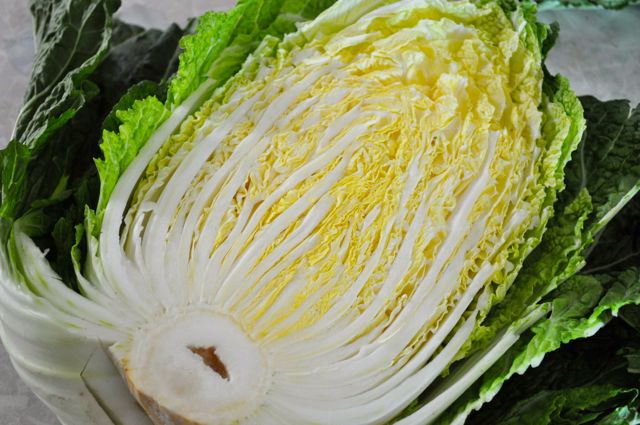
Cabbage (배추 Baechoo) – If you can, buy Korean napa cabbages – they are the best. The better ones are more bigger and heavier with the inner core packed with leaves. A single firmly packed medium size Korean napa cabbage weighs about 3 ~ 4lbs.
Radish (무우 Moo) – Korean radishes are similar to Daikon radishes but are more flavorful and less juicy. Some radishes have little air holes inside which means it’s dried out and will turn spongy. Choose ones that are heavier than others. When cutting radish, my mother-in-law told me that you should pay attention to the grain and cut WITH the grain. This way, the radish remains flexible (and not break) when salted.
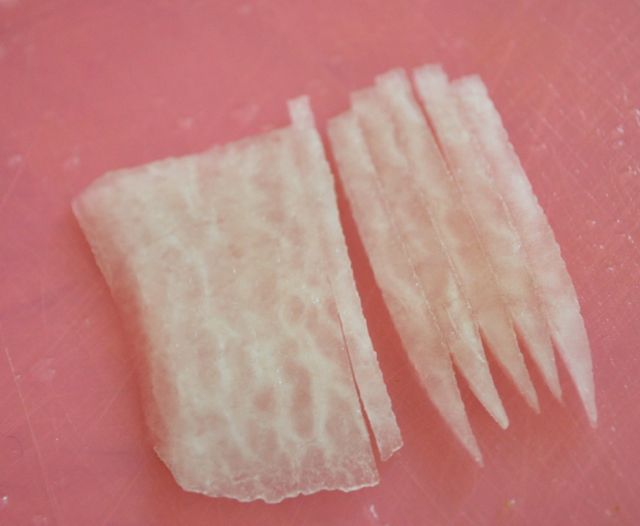
Salt (소금 Sokeum) – Salt is very important in Kimchi. Use sea salt but with the bittern removed. In the old days, people stored a whole sack of solar sea salt (for at least 1 year) on top of bricks while the bittern slowly drained.
Today, companies sell solar sea salt that have been aged for 3 -5 years which means the bittern has been drained for 3-5 years (like the one I mention in K ingredients). If the salt has too much bittern in them your Kimchi may turn out bitter tasting so be careful when you are using sea salt and taste it to see if you can taste any bitterness.
When pickling cabbages, a 1/2 C ~ 1 C salt : 5 C water ratio salt water should work well. And always remember to set aside some of the salt to sprinkle directly in between leaves to ensure even pickling. In warm weather, pickle for 4~6 hrs and in cold weather 8~12 hrs. But always the best way is to touch and see how it looks. See my part1 post to see a pic of pickled cabbages.
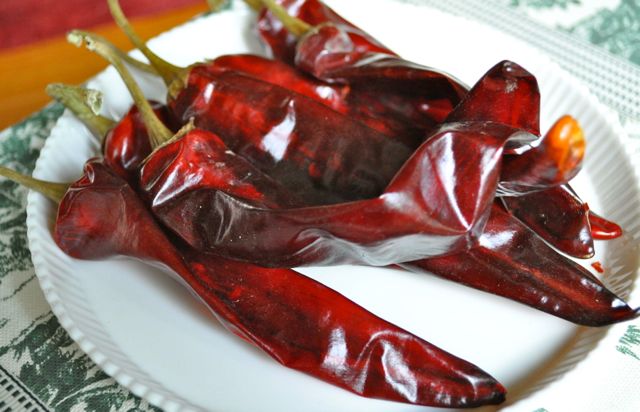
Red chili powder (고추가루 Gochookaroo) – Chili powder can totally make or break a Kimchi. Korean red chili peppers are spicy but not too spicy and also have a bit of sweetness that makes Kimchi taste good. If there’s one thing you should try to buy from the Korean market, it’s the chili powder. Typical amount to use is 1 C of Gochookaroo per 1 cabbage (4 lb size).
Ginger – There is a native Korean ginger that some people like to use but because you use a small amount it does not make a big difference so no need to worry here. Use less ginger if you want to store your kimchi longer.
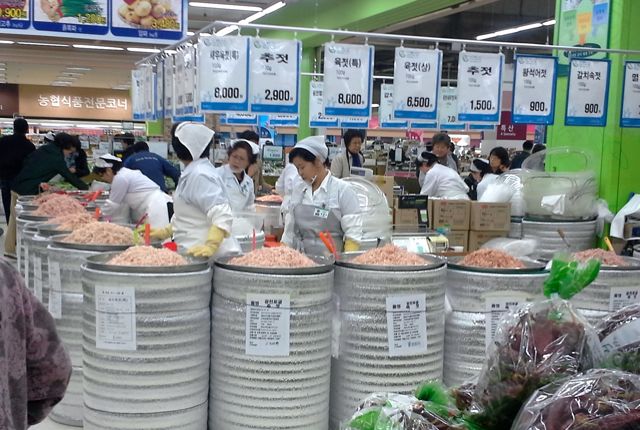
Fermented Fish/Seafood (젓갈 Jeotgal) -Jeotgal is another very important ingredient in Kimchi. What kind of jeotgal you use is very much a personal preference. The better ones should taste pretty good on their own – quite salty, not fishy(the kind of fishy that tastes not fresh) and even a little bit sweet. Anchovy and shrimp jeotgal are your basic must haves. My mother-in-law told me that Kimchi will ripe slower and last longer if you use mostly anchovy jeotgal. Thus, Koreans who live in southern provinces tend to use more anchovy joetgal and Koreans who live in the central and northern part tend to use more shrimp jeotgal. What jeotgal you use also depends on what kind of kimchi you are making – more shrimp for Kkaktooki and more anchovy for Kimchi that are made with greens such as chives and mustard leaves.
The picture shows all the different kinds of saewoojeot that you can buy based on where it is from and also when they are made. Saewoojeot made in May is called 오젓 Ohjeot, in June is called 육젓 Yookjeot and in the fall it’s called 추젓 Choojeot. June jeotgal (Yookjeot) is the best for Kimjang.
I know it’s hard to get all these fancy fermented jeotgal outside of Korea so just use one or more of the bottled fermented anchovy sauce (멸치액젓 myulchi aekjeot), fermented sand lance sauce (까나리액젓 kkanari aekjeot) or fermented shrimps (새우젓 saewoojeot). If you can’t even get these, use any Asian fish sauce.
Rice Paste VS Flour paste for Kimchi?
This is another ingredient that varies a lot based on the recipe and puzzles even Koreans as to whether this is a necessary ingredient. There are different opinions and I personally prefer not using the paste so it was not included in my Kimjang recipe. But you are welcome to add it if you wish.
There are 2 main reasons for adding paste in Kimchi.
- It gets rid of any “grassy” smell and taste from some Kimchis. When making Kimchi with dark green vegetables (radish leaves, Korean small cabbage, mustard leaves, etc but NOT napa cabbage), it can sometimes taste and smell grassy. The only way I can explain “grassy” is that it would be mildly similar to eating wheat grass or something that is so green that it tastes really raw and even bitter. Rice or flour paste is a must for these green kimchis and also for radish kimchis like Kkaktoogi.
- It helps to ripen Kimchi faster and taste sweeter. Because it serves as food for the many beneficial lactic acid bacteria that helps ripen Kimchi, it speeds up the fermentation process. So if you don’t want to ripen your Kimchi too fast, don’t add any paste. Personally I think it diminishes the fresh taste of Kimchi and takes away some of the zing that I love in a great Kimchi. But some people (many from the Southern region) actually prefer it this way and they say it deepens the taste and has a more concentrated flavor.
FAQ
- Q: What if I don’t have access to Jeotgal?
- A: You would think that it would be impossible to make Kimchi without some kind of fermented seafood. But it’s actually not true. An easy possible substitute is Fish Sauce (which is usually readily available than Korean jeotgal). But you can completely omit jeotgal and just add some fresh shrimp, fish stock (dried anchovy or pollock) or beef stock(with fat removed) instead.
- Q: My Kimchi is not salty enough. Can I add additional salt after Kimchi has started to ferment?
- A: It is best not too. Adding additional salt afterwards can actually make it taste bitter. But before it has started to ferment, you can take out some of the juice, add salt and mix, then add it back in.
- Q: How can I make my Kimchi not sour too quickly?
- A: The saltier you make your Kimchi, the longer it will take to ripen and also will not sour as quickly. Not adding paste or jeotgal will slow down the ripening process. Koreans sometimes make Kimjang Kimchi with just salt so they can make it last till summer. Adding sugar will make Kimchi taste sweeter but also sour faster. Let it ripe but then keep it in very cool temperature – see No Crazy Kimchi post for more info on how to ripen Kimchi.
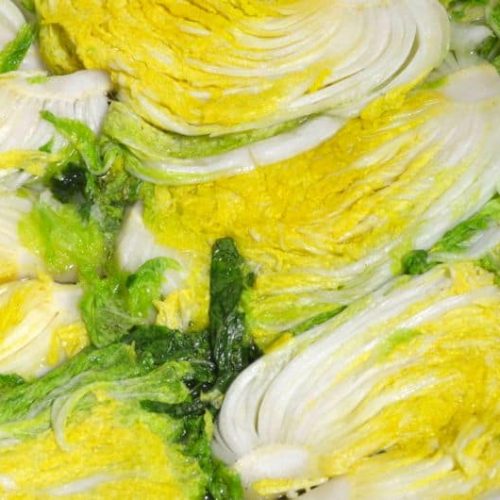
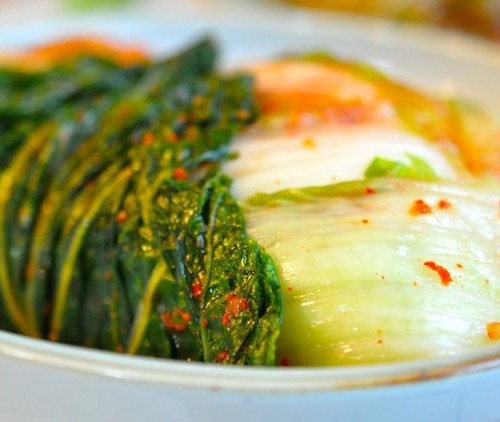



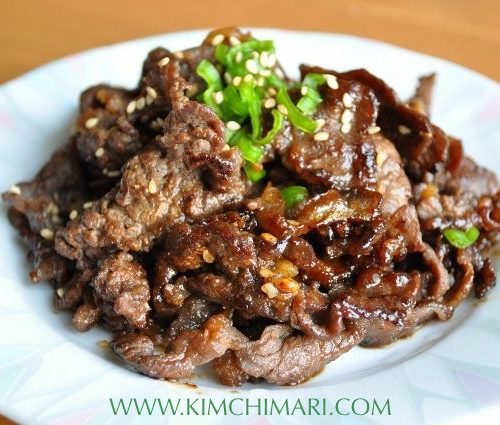
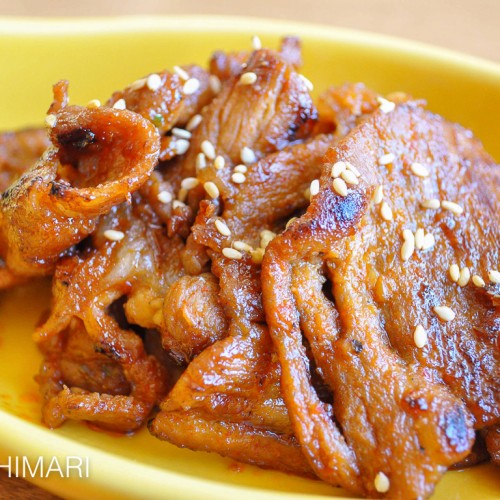

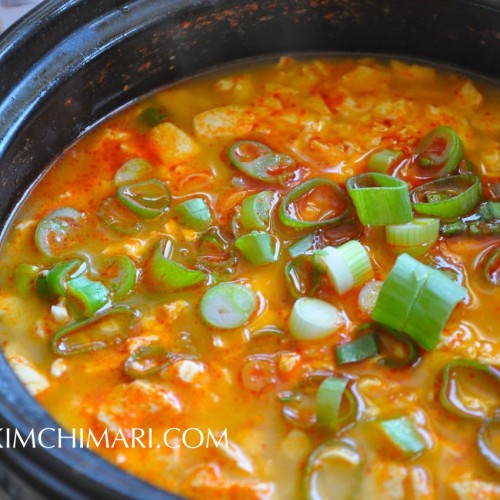
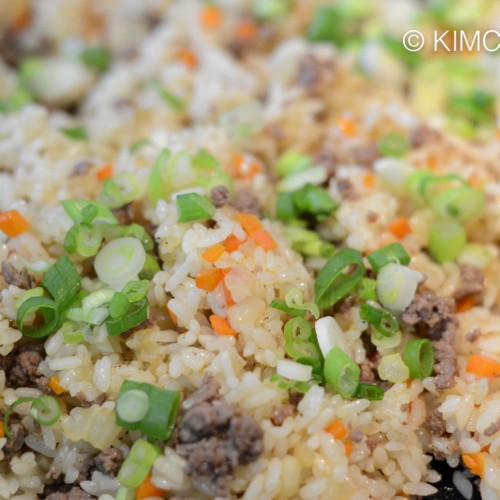
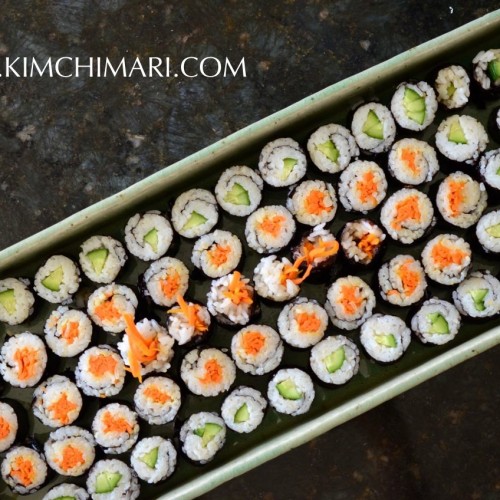









*gasp*
Ohhhh I did not know fish sauce used in kimchi.
Is there a tactful way to ask Mom and Pop Korean Restaurant owner what Fish Sauce they use??? Anchovy only would be fine. Shrimp, eh no, not kosher and besides, I discovered the hard way that I actually DO have an allergy to shrimp. Not coooool. Ohhh noooo Whatever shall I do with the kimchi in my refrigerator??
Yes, I am afraid so. It would be hard to find cabbage Kimchi that doesn’t use fish sauce. Fermented shrimps may or may not be added. I think it would be totally fine for you to just ask directly if they added “saewoojeot”. If they did then yes, although a very minute amount – your kimchi does contain shrimp. Perhaps you can ask them to make you a special batch with no saewoojeot? I wish you all the best in finding the right Kimchi for you. Perhaps you can make it yourself soon.. Take care,
Kimchimari I was wondering if you could use a bit of cornstarch and a bit of sugar to substitute for the sweet rice flour. I had some sweet rice flour but someone “cleaned ” the cabinets and didn’t know it’s value. Sad face
Hi Ramona, Oh dear.. that’s too bad..I have never heard of anyone using cornstarch (I don’t think it will work) but you can certainly make a paste out of regular flour. Some actually prefer that instead of sweet rice flour paste. And no need to add extra sugar for the ‘sweet’ part but certainly welcome to add a little bit for taste. Hope it turns out well for you!! Thank you for asking!
I use cornstarch (cornflour) and it works fine.
Great! Good to know – thank you so much for sharing.
Except for one occasion all the kimchi I have eaten (store purchased) is bitter tasting, sour and hurts my teeth. I want to make my own with salted shrimp but don’t want that bitter sour flavor. Is it in the brining of the cabbage that makes the difference. The one I had was made by a friend of my niece who brined the cabbage for 6 hours.
Reason for bitterness is most likely the type of salt used. As I noted in my posts, you need to use salt with the bittern removed in brining the cabbage to avoid the bitter taste. Brining for 6 hrs sounds find. The sour flavor is because the kimchi has been fermenting too long. If you make your own kimchi you can definitely avoid that. Hope this helps! hope to hear how your kimchi turned out!
Where do u get the salt you speak about? Is kosher salt
Free of bitten. So it doesn’t sour how long should
It ferment before refrigeration?
Also thank you for responding back.
Yes, Kosher salt is usually free of bittern. You can also buy Korean solar sea salt from Korean markets or online (search “Korean sea salt” under shopping category). Shinahn (신안) is a good brand. Also Hmart sells online. You can read my No Crazy Kimchi post for more details on how to ripen Kimchi without souring. Hope this helps!
Thank you for your help. Could you link me to the whole recipe
So I can make it. I have kosher salt but will look
Into the Korean sea salt. There is a large Korean
Market in Atlanta that I might try to find it there.
https://kimchimari.com/2013/12/09/my-first-kimjang-at-home-tips-on-brining-cabbage-for-kimchi/ is the post for brining kimchi cabbage.
https://kimchimari.com/2012/12/12/kimjang-how-its-done/ has the basic recipe for making cabbage kimchi. Oh, the Korean market will def have sea salt. Good luck!
Hi JinJoo,
I ‘ve just made a batch of kimchi three weeks ago. I’ve tried adding extra two Asian brown pears to reduce the raw sugar portion needed ,otherwise the ratio of the sugar and salt are just the same as before. And I cooked and prepared the porridge paste using sweet glutinous flour as I like the thick texture for kimchi.
But I noticed that the liquids in the kimchi box two days even before I actually put them into the fridge was rising..it produced lots of liquids and its thins down the kimchi mix..
*I wonder could it be the extra sweetness from the pears and the numbers of days I left it to ferment (25-29 degree) that causes the kimchi to turn out sour with runny liquids ?
Otherwise, the kimchi tasted very good.
*I’ve also tried earlier instead of sweet glutinous flour porridge, I grabbed some corn flour (that is the only ‘porridge paste’ at that moment ) to add them into the Korean peppers,garlic,ginger,asian pears..etc to make an instance kimchi for my family. To my surprised it taste so refreshingly tasty that we finished a slightly over two kg cabbage in just three days.
I wonder is it alright to use other flour besides sweet glutinous flour as the porridge paste?
Hi Sherri, yes, I think it was a combination of the pears having more sugar and more liquid (remember asian pears have a LOT of juice) that produced more liquid. And leaving it out at 25-29 deg. temp for 2 days is probably a bit too much. I would check after 6-8 hrs in warmer weather to adjust how long you leave in room temp. Kimchi is really fickle…any bit of change and you have a very different result.
People use sweet rice flour, plain rice flour and regular flour for the paste. I have never heard of anyone using corn flour but if it turned out good for you, why not? As I mention, using paste in Kimchi is not an absolute requirement. It just depends on personal taste. So glad to hear about your Kimchi making stories…hope you are having a good summer. Talk soon! take care
JinJoo, I’m finally getting caught up with my life and here’s what I’ve been up to. On Seollal, I had my own Kimjang! Well, I’m the only one, so it’s not much of a kimjang, but I put up about 40 pounds of kimchi! I did a double batch of the recipe I’ve been using all along, and I put up 2 batches following your recioe – one with shrimp jeotgal (I bought it in bulk at KyoPo!) and one with croaker (“yellow fish” – I’m guessing that was croaker) jeotgal just to see if there would be a diffference (I couldn’t get anchovy). It all went into the kimchi fridge, which is holding it at 28 degreed F. The problem is, of course, it will take forever to ripen, so I’m taking out a section at a time to the counter for a day or three, and then into the regular fridge, so that I have something to eat!
The only problem is that it’s not releasing a lot of liquid which is still about a half to one inch below the top, so things aren’t submerged. The top leaves are a little frozen (crispy!) but otherwise it all seems fine.
I need to get some half sized containers for my fridge – they’re slightly smaller than the ones I find aroun here (looks like the LG uses a different size than the Samsung, which is what’s sold locally, or maybe it’s because it’s older). The’re trally too big for me, and i’d like to have some more varieties but I run out of space at 4 ocontainers, so I have room for one more. Thaks for being part of this adventure of mine – sorry I’ve been out of touch for so long.
So good to hear from you!! And same here, so sorry for not replying sooner. I have been a bit busy with my classes and then traveling to the US for a few days to see my sisters. So excited to hear about all the different kimchis you made! Please let me know how they turned out.
I totally understand about wanting to get smaller containers – they do come in quite handy. If you feel you really are not getting enough liquid (sometimes due to your radish and cabbages being more on the dry side), you may try adding some additional broth made from kelp and dried anchovies. I think I discuss it on my post.
Talk to you soon! And thank YOU for sharing your adventures on my blog. Take care,